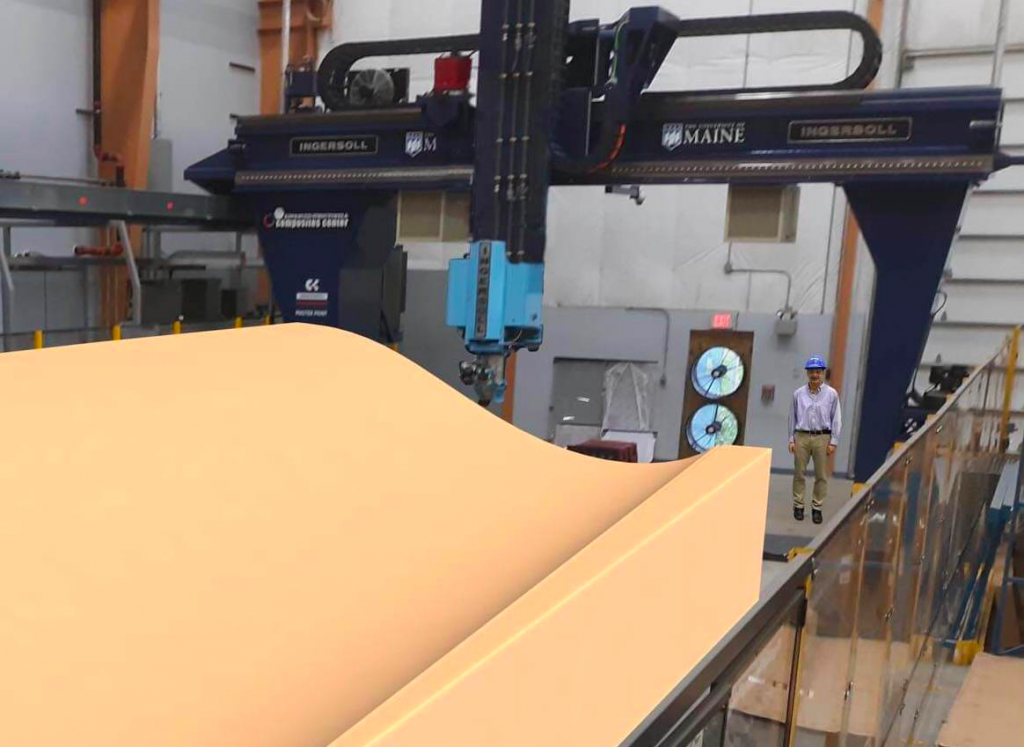The University of Maine (UMaine) has secured $2.8 million in funding from the U.S. Department of Energy (DoE) to develop a more eco-friendly method of 3D printing wind turbine blade molds.
By introducing a bio-based feedstock into their Cellulose Nanofiber (CNF) printing process, the UMaine team believe that it’s possible to cut the costs of producing the large-format parts by 50%. As part of the project, Oak Ridge National Laboratory (ORNL) will also integrate 3D printed heating elements into the mold, as the joint-research group aims to expedite the R&D of green energy technologies.
“The University of Maine remains a leader in AM and wind energy technology, and this funding will harness researchers’ expertise in both areas,” U.S. Senator Susan Collins said at the announcement of the award. “We are thrilled that the Department of Energy continues to invest in UMaine’s cutting-edge research.”

UMaine’s CNF 3D printing process
Backed by ORNL and the DoE, UMaine researchers have been developing their CNF approach since May 2019. Primarily, the team’s research is centered on the R&D of a novel wood-based feedstock, and assessing its suitability for 3D printing, by carrying out multi-scale modeling and sustainability life-cycle analyses.
The material itself is based on nanocellulose, a variation of the cells found in green plants, which have the same tensile strength as aluminum as well as non-toxic qualities. While the renewable fibers have often been used to fabricate smart dressings within healthcare applications, the UMaine team has increasingly deployed them to create larger structures, such as a 25-foot 3D printed boat.
Utilizing a custom large-format machine created by Ingersoll Machine Tools’, UMaine’s researchers have been able to produce a record-breaking 5000-pound vehicle, which they call the ‘3Dirigo.’ Elsewhere, the system has also been deployed by the U.S. Army’s CCDC Soldier Center to 3D print 12-foot-long shelters, and the researchers have now opted to collaborate with Ingersoll again, to fabricate sizeable wind turbine blade components.

Fabricating eco-friendly turbine blades
At present, the molds and tooling required to design and build turbine blades can cost upwards of $10 million, and the time-consuming process often takes 16-20 months to complete. As a result, by the time novel designs make it to market, they can already be out of date, disincentivizing innovation in what is a growing industry.
That’s why UMaine’s Advanced Structures and Composites Center is developing a lower cost, more rapid method of 3D printing the molds instead. During their $2.8 million project, the UMaine team intends to use what they call the “world’s largest polymer printer” alongside recyclable feedstock and wood supports, to fabricate massive plastic molds.
The researchers estimate that their novel process could yield cost savings of 25-50%, while reducing the lead times of turbine blades by up to six months. As part of another $4 million award, UMaine will also collaborate with ORNL, to experiment with robotically depositing continuous reinforcing fibers into the additive blades.
Given that it’s vital to control mold surface temperatures during production, ORNL predicts that its heating elements will serve to deliver further time and cost reductions. Overall, the project’s outcomes could prove significant, as leading turbine suppliers TPI Composites and Siemens Gamesa (SGRE) are closely monitoring its progress.
If the researchers’ CNF technique can be demonstrated successfully, it could convince SGRE and TPI to apply it within end-use applications. Similarly, Ingersoll Machine Tools and material compounder Techmer PM are also collaborating on the program, as the research team seeks to make their approach more scalable.
Additive turbine applications
Although 3D printing turbine blades is a relatively new application of the technology, it’s starting to attract the interest of the energy industry’s major players.
For instance, the DoE has awarded $1.2 million to computational materials design specialist QuesTek Innovations, to develop new materials for 3D printing gas turbine blades. QuesTek’s niobium-based alloys could yield parts that provide increased fuel efficiency when operating at higher operating temperatures.
Elsewhere, GE Renewable Energy has leveraged COBOD’s concrete 3D printing technology to fabricate record-tall wind turbine towers. The large-scale project is designed to boost renewable energy generation while lowering its overall cost of production.
Similarly, engineers from Purdue University are developing a method of 3D printing concrete wind turbine parts. The team claims that printing off-shore turbine anchors on-site instead of manufacturing them out of steel and shipping them there, could yield significant cost savings.
To stay up to date with the latest 3D printing news, don’t forget to subscribe to the 3D Printing Industry newsletter or follow us on Twitter or liking our Facebook page.
Are you looking for a job in the additive manufacturing industry? Visit 3D Printing Jobs for a selection of roles in the industry.
Featured image shows a segment of one of the UMaine team’s 3D printed wind blade molds. Photo via UMaine.



